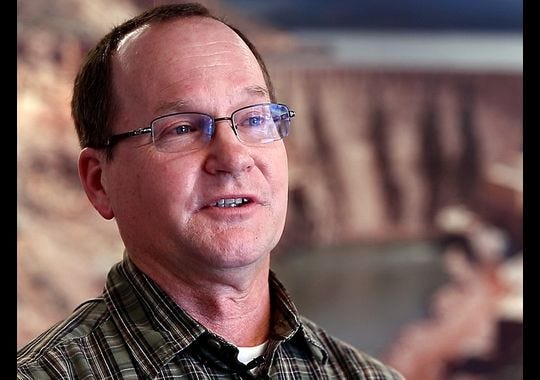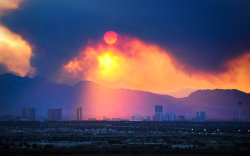Results 1 to 2 of 2
Thread Information
Users Browsing this Thread
There are currently 1 users browsing this thread. (0 members and 1 guests)
-
07-09-2013, 06:27 PM #1
Water worries: Climate change in the desert Southwest
Water worries: Climate change in the desert Southwest
Doyle Rice, USA TODAY 5:56 p.m. EDT July 9, 2013
Special report: USA TODAY will explore how climate change is affecting Americans in a series of stories this year.

The Central Arizona Project Canal is east of Scottsdale, Ariz.(Photo: Tom Tingle, The Arizona Republic)
Story Highlights
- Phoenix gets less rain each year than any other major U.S. city
- One climate scientist says drought is "monumental"
- Nighttime temperatures aren't cooling off and present another threat
PHOENIX — The canal, its blue water sparkling in the morning Arizona sunshine, has been there in some form for more than a thousand years.
More than 10 centuries ago, Native Americans dug canals to bring water — the desert's most precious resource — into their farms and communities in the harsh climate of what's now Phoenix.
Today, the 56 million Americans in the fast-growing desert Southwest — including those in the megacities of Phoenix, Los Angeles, Las Vegas and San Diego — are faced with a challenge beyond the region's natural dryness: coping with an uncertain future of man-made climate change and how it will impact their life-sustaining supply of water.
And while worries about water lead the list of climate change concerns in the Southwest, other issues, such as extreme heat waves and furious wildfires, are also high on the list.
Climate change is a special concern in the Southwest, as the region continues to lead the nation in population growth, according to the U.S. Environmental Protection Agency.
USA TODAY traveled to Arizona as another stop in a year-long series to explore places where climate change is already affecting America.
 The series will look at different regions of the country.(Photo: USA TODAY)
The series will look at different regions of the country.(Photo: USA TODAY)
NEVER ENOUGH WATER
"Water is our biggest issue," says Arizona state climatologist Nancy Selover from her office on the campus of Arizona State University. In the desert, "you can never have enough water."
How dry is Phoenix? By far, Arizona's capital city gets less rain each year than any other major U.S. city. For instance, Phoenix receives about 7.5 inches of rain a year, which is close to what Mobile, Ala., receives in an average July, according to National Weather Service data.
Also, climate change isn't just a worry for the future: Several direct effects of climate change are already impacting the water supply in the Southwest, according to a report released this year as part of the draft of the third federal National Climate Assessment.
"Recent drought has been unusually severe, relative to the droughts of the last century," the report states, "but some droughts in the paleoclimate record were much more severe."
Paleoclimatology is the study of past climates using data from sources such as tree rings, rocks, and sediments. Some paleoclimate records go back as far as 2,000 years, notes Gregg Garfin, a climate scientist at the University of Arizona and one of the editors of the assessment.
Additionally, "recent flows in the four major drainage basins of the Southwest have been lower than their 20th-century average," the report states.
The current drought is "monumental," Garfin says.
Water flow in the Colorado River — which supplies water to more than 30 million people in the Southwest including Los Angeles, Phoenix, and Las Vegas — is declining, along with the spring snowpack in the mountains that feed the river due to increased warmth.
Temperatures in the Southwest are also rising more quickly than in other regions of the nation as a result of climate change, according to a recent climate change paper prepared by the White House. Specifically, Arizona is the fastest-warming state in the nation, based on data from 1970 to 2011, warming at a rate of 0.6 degrees per decade, a Climate Central report found.
"I don't believe we can sustain the status quo" when it comes to water use and management in the Southwest, Garfin says.
Other future impacts of water use in the Southwest due to climate change include: decreases in average precipitation and in late-season snowpack, and declines in river flow and soil moisture. Droughts are expected to become hotter, more severe, and more frequent, the federal assessment reports.
DOES PHOENIX HAVE IT FIGURED OUT?
Flying over the harsh but gorgeous desert landscape of Arizona in a helicopter in late-May provides a bird's-eye view of the system in place to bring water to the thirsty people of Phoenix, the nation's fifth-largest city. A massive series of reservoirs, dams and canals from the Salt and Verde Rivers are in some of the same locations as those that the Hokokam Native American tribe built centuries ago.
"We've planned for drought and built for drought," says Charlie Ester, the manager of water resource operations for the Salt River Project, which supplies much of the water and energy for Phoenix. "We're ideally situated to deal with climate change in the Phoenix area," he says.
 Charlie Ester, water resources operations manager for the Salt River Project in Phoenix, talks about how climate change may affect water and water usage in Arizona.(Photo: Tom Tingle, The Arizona Republic)
Charlie Ester, water resources operations manager for the Salt River Project in Phoenix, talks about how climate change may affect water and water usage in Arizona.(Photo: Tom Tingle, The Arizona Republic)
"Arizona and New Mexico have extreme natural variability, and we expect climate change to exacerbate those extremes," Ester says. He predicts that Phoenix "can get through any drought in the historical record."
Garfin says that Phoenix's ability to deliver water successfully is due mainly to its three separate sources of water: the Colorado River; the Salt and Verde Rivers and their reservoirs; and their underground water supply.
So even though the supply from the Colorado River might be dwindling, Garfin says that Phoenix may very well be able to continue to deliver water in the decades to come due to their other two well-stocked sources of water.
Also, water management agencies in Arizona say they believe they have been very progressive in how they manage their future water supply: Any new development must prove that there will be enough water for the residents for 100 years.
"If water supplies are not adequate for 100 years, then development won't get approved," says Kathleen Ferris, executive director of the Arizona Municipal Water Users Association. "There's no other state that's required to prove a 100-year water supply for new homes."
But is it enough? "They've got their eye on the ball in Phoenix, and have made big changes in planning," Garfin says. "They've paid attention to the science and are taking it seriously.
But do they really know what climate change will throw at them?" he asks. "What about abrupt change, or a 50-year drought? Can they sustain water supply for the longest droughts that we've known in the Colorado River basin?"
While Phoenix may be able to withstand a future with climate change due to its three water sources, other locations in the Southwest may not: Garfin says that the most vulnerable areas for water in the Southwest are New Mexico, California, the Colorado Front Range, and Las Vegas.
BEYOND WATER
Extreme heat waves and devastating wildfires are also expected to worsen in the U.S. Southwest because of climate change, according to the federal assessment.
"We are concerned about heat," Selover says. "Out here, heat is the biggest weather killer," she says. Indeed, heat-related deaths in Arizona are the highest of any state, according to the Centers for Disease Control and Prevention. Overall, summer heat waves, such as the one that baked the Southwest this month, are forecast to become longer and hotter, the assessment reports.
What's most concerning, Selover says, is that nighttime temperatures are not cooling off: "Nighttime temperatures have increased especially rapidly," according to a report from Climate Nexus, a climate communications group. "It makes heat waves more miserable and dangerous for humans, who get no break from the heat."
In fact, the period since 1950 in the Southwest has been hotter than any comparably long period in at least 600 years, the federal draft assessment reports.
Additionally, wildfires will be a significant issue in the Southwest in the decades to come. "We're seeing that with the drought conditions and more warmth, there is more potential for wildfires," Selover says. While there may be a reduction in the number, the ones that do form are much larger, according to a report from the Arizona Department of Forestry.
"There is a very clear, intuitively sound relationship between climate and fire," notes Jennifer Marlon, a research scientist at Yale University. "With warmer, dry conditions you tend to get a lot more forest fires, and the opposite is true for cold and wet conditions. We found that fires are very sensitive to temperature changes; when you increase the temperature, you get more fires."
http://www.usatoday.com/story/news/2013/07/09/southwest-climate-change-drought/2439191/NO AMNESTY
Don't reward the criminal actions of millions of illegal aliens by giving them citizenship.
Sign in and post comments here.
Please support our fight against illegal immigration by joining ALIPAC's email alerts here https://eepurl.com/cktGTn
-
07-09-2013, 09:04 PM #2
 Largest Nev. fires still growing near Vegas, Reno
Largest Nev. fires still growing near Vegas, Reno
LAS VEGAS (AP) — Fire crews worked Tuesday to stop two large Nevada wildfires advancing through rugged mountain areas, including one that billowed smoke visible from downtown Las Vegas and another southwest of Reno, while administrators added resources and began looking to the weather to help . . .
Associated PressNO AMNESTY
Don't reward the criminal actions of millions of illegal aliens by giving them citizenship.
Sign in and post comments here.
Please support our fight against illegal immigration by joining ALIPAC's email alerts here https://eepurl.com/cktGTn


 LinkBack URL
LinkBack URL About LinkBacks
About LinkBacks




 Reply With Quote
Reply With Quote


Mike Johnson betrays border security for more foreign aid
04-18-2024, 10:31 PM in illegal immigration News Stories & Reports